How to connect an LED strip
With the advent of LED lamps, it became possible to make the lighting design of apartments and houses more diverse. And when they came up with flexible strips with small LEDs attached to them, which can glow in different colors and even change color smoothly, only imagination is required: connecting an LED strip is not difficult. Having done the operation once, you can easily repeat it.
The content of the article
Types and types
Before connecting the LED strip, you should understand their types and markings. So you will not be mistaken with the choice of the power supply and will accurately calculate the required glow intensity, tape length and other parameters.
Colors and types of glow
You've probably noticed that LED strips differ in the type of glow. They are:
- Monochrome. They are assembled from elements of the SMD type, give out a certain color. The marking indicates the initial letter of the English spelling of the color:
- LED-W-SMD - white (can be tinted blue or yellow, also called warm or cold light),
- LED-R-SMD - red,
- LED-B-SMD - blue,
- LED-G-SMD - green.
- Universal. Marked RGB - give different shades depending on the command from the control panel. They work in tandem with a controller and a control panel.
The most popular tapes for interior lighting are ribbons made of monochrome - monochrome - crystals. The constant change of colors is too stressful, does not allow you to relax. This is illumination, not illumination. Therefore, universal tapes are used to create advertisements, highlight cars - where it is necessary to attract attention. When decorating interiors, mainly SMD tapes are used.
Degree of protection
Since the field of application of LED strips is extensive, the degree of protection is different. For dry rooms, conventional open ones are produced - without a protective coating. There are waterproof ones - they can be used in damp rooms - in bathrooms for example. They are covered with a layer of varnish. There is another option - moisture resistant. They are sealed in a sealed housing and can be mounted directly in the water - in an aquarium, pond or pool. They can also be used for outdoor lighting.
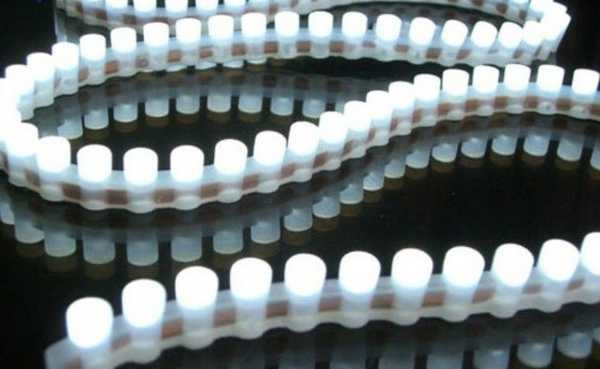
Sealed tapes for illuminating aquariums, swimming pools or decorative ponds
For exterior car styling, LED strips are most often used, placed in a transparent polymer tube. It protects not only from moisture penetration, but also from mechanical damage, but their cost is higher.
Sizes of LEDs, their brightness and density
Let's figure out the dimensions. If you take several strips, you can see that they are made of LEDs of different sizes. In addition, they are sometimes located tightly next to each other, in some - at a fairly decent distance, and there are also tapes with LEDs in two lines.
It is not difficult to distinguish the dimensions of the elements externally, but how to understand this by the marking. The dimensions are shown in numbers after the letters that indicate the type of LED. For example, LED-R-SMD3528 (red) and LED-RGB3528 (universal) are assembled from elements with dimensions 3.5 * 2.8 mm, LED-G-SMD5050 (green) and LED-RGB5050 (universal) - 5.0 * 5.0 mm.
These are the two most common types, although there are larger ones - 56 * 30 mm, and there are also smaller ones - 20 * 20 mm.
The larger the crystal, the more intensity of light they give out. For monochrome crystals, the indicators are as follows:
- measuring 3.2 * 2.8 mm gives a luminous flux from 0.6 to 2.2 lm;
- size 5.0 * 5.0 mm - from 2 to 8 lm.
Universal LEDs with the same dimensions have a lower intensity: three small crystals of different colors are soldered in one case, therefore the RGB luminescence intensity is lower:
- 3.2 * 2.8mm gives out 0.3 to 1.6 lm;
- with dimensions 5.0 * 5.0 mm - from 0.6 to 2.5 lm.
All values are given for crystals without a protective coating. Any of them reduces the intensity of the glow and this must be taken into account when calculating the brightness of the glow.
Length calculation
Above we were talking about each individual LED on the tape, and there are many of them on the tape and they are located with different densities, respectively, they can produce a stream of light of different intensities.The minimum number of crystals per meter is 30 pcs, the highest density in one row is 120 pcs / m, in two rows - 240 pcs / m.
Depending on the number of crystals, the total luminescence intensity and electrical power consumption also change. For the convenience of calculating the required lighting intensity and electrical parameters, the technical data are summarized in a table.
From this table you can determine how long the backlight tape is needed. For example, you want to make a backlight in a room, a medium intensity glow. Replace two 80 W incandescent bulbs. It is necessary to organize a luminous flux of about 140 W (two 80 W lamps will never give 160 W).
If for these purposes we take SMD3528 with the number of LEDs 120 pcs / m, you will need about 5 meters of tape (we take with a margin of 20%), SMD5050 with an installation density of 60 pcs / m will require 4-4.5 meters.
In general, LED strip is sold by meters. It comes from the factory in bobbins of 5 m and a piece of this length is not always necessary. Therefore, it is possible to cut off the required amount: along the dotted lines with the image of scissors. Strictly along these lines and can be cut.
If the scissors are not drawn, then there must be a dotted line. Also, the cut line can be determined by the presence of contact pads on both sides of the line.
Connecting LED strip
Most of the LED strips are 12V or 24V. If there is only one line of crystals, 12 V is required, if there are two, 24 V is required. Any DC source that supplies this voltage is suitable: battery, power supply, battery, etc.
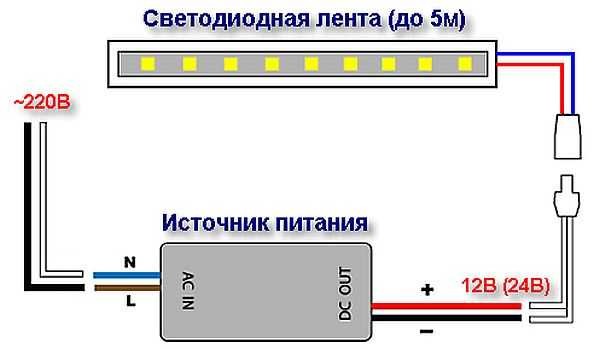
Diagram of connecting the LED strip to a 220 V network through a power supply
To connect the tape to a 220 V household network, a converter or adapter is required (also called blocks or power supplies, adapters).
Recently, tapes have appeared that can immediately be connected to a 220 V network. All of them are sealed in plastic tubes - 220 Volts is no longer a joke. They are also cut along the marked lines, connected using a special connector that is inserted into the conductors. A cord with a built-in rectifier is connected to the connector (this is a diode bridge and a capacitor).
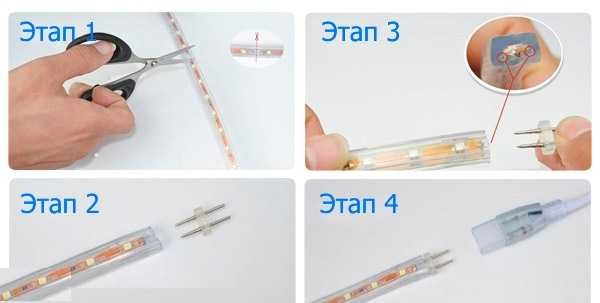
Connecting a special LED strip to a 220V network
This tape differs from the usual one in that small sections (20 pieces) with LEDs are not connected in series, but in parallel, and also so that the diodes are directed towards each other. Due to this, we get the required voltage of 220 volts or so. The alternating current is converted to direct current by means of a diode bridge, and the ripple is damped by a capacitor.

Connection diagram for LED strip without power supply
In principle, such a tape can be assembled from an ordinary one, but you will need to take care of insulation: touching an element connected to a household network without an adapter is fraught with serious consequences.
How to connect multiple LED strips
Each of the tapes, depending on the modules used and the number of elements per meter, consumes a different amount of current. Average parameters are shown in the table. Knowing how long you want to mount the backlight, you can choose an adapter that will deliver the required current.

Current consumption table for LED strips powered by 12 V
Sometimes the required tape length exceeds 5 meters - when it is necessary to illuminate the room around the perimeter. Even if the power supply can deliver the required current, it is impossible to connect two or more five-meter tapes in series. The maximum permissible length of one branch is the 5 meters that come in a reel. If you grow it by connecting the second one in series, a current will flow along the tracks of the first tape that is many times higher than the calculated one. This will lead to rapid failure of the elements. The track may even melt.
If the power of the power supply is such that several tapes can be connected to it, separate conductors are pulled to each of them: the connection diagram is parallel.
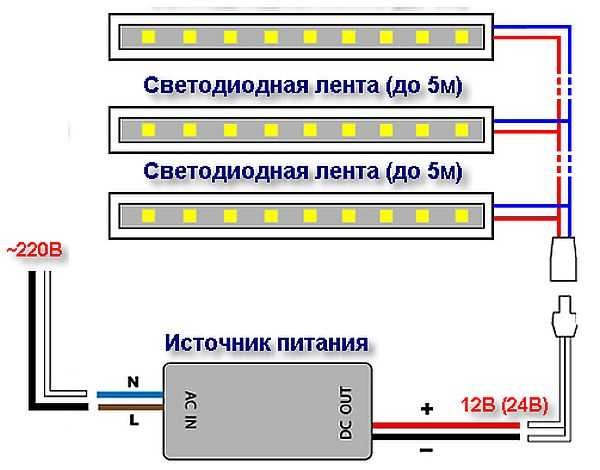
How to connect multiple LED strips to one power supply
In this case, it is convenient to place the power supply unit in the middle, for example, in the corner, and from it - two tapes on both sides. But it is often cheaper to buy several less adapters than one more powerful one.
Connecting RGB tape via a controller
First the power supply is connected in series, then the controller. They are connected to each other with two wires. There are already 4 conductors coming out of the controller, which are wired to the corresponding contact pads of the RGB tape.
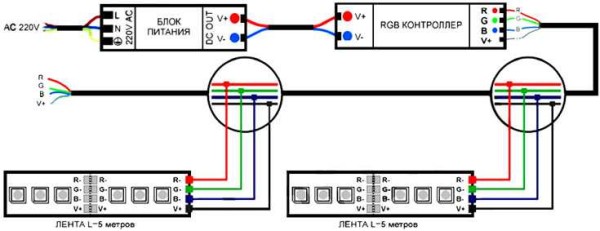
Connecting RGB LED strip via controller
Just like in monochrome ribbons, in this case the maximum permissible length of one line is 5 meters. If a longer length is required, then two bundles of wires of 4 pieces each leave the controller, that is, they are connected in parallel. The length of the conductors can be different, but it is more rational for the power supply and the controller to be in the middle, and two backlight branches go to the sides.
Connection methods
Connecting the LED strip to the power supply is serial. Therefore, we pay attention to the polarity: we connect "+" only to the same pole, and "-" - to the minus.
At the end of the tape, which comes on a reel, conductors are soldered. If the glow is monochrome, there are two conductors - "+" and "-", for multicolor 4, - one common "plus" (+ V) and three colored (R - red, G - green, B - blue).

Pure bobbins
But a 5-meter piece is not always needed. shorter lengths are often required. Cut the tape along the marked lines.
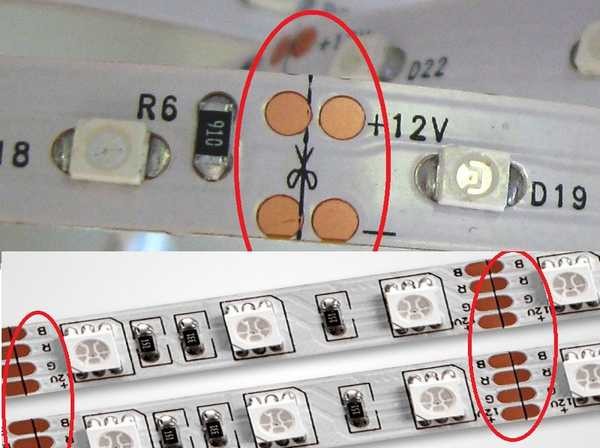
Cut lines on LED strips
In the photo, you can see the contact pads on both sides of the cut line. They are signed on each tape, so it is rather difficult to get confused when connecting. To make it even easier, use different colored conductors. This will make it clearer and you definitely won't get confused.
Connectors
You can connect the LED strip without soldering. There are special connectors for this. These are specially designed devices - plastic cases that provide proper contact. There are connectors:
- for connecting conductors to the tape;
- connection of two tapes.
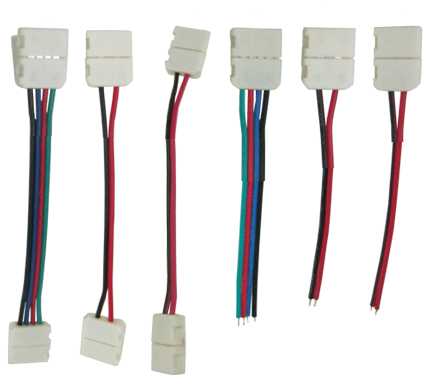
Different types of connectors
Everything is very simple: the lid is opened, the tape or conductors with bare ends are inserted. The lid closes. The connection is ready.
The method is very simple, but not very reliable. The contact is made only by pressure, and if the cap loosens a little, problems begin.
Soldering
If you have at least some soldering skills, it is better to use this method. For work, you need a medium-power soldering iron, with a thin or sharpened tip. You need rosin or flux, as well as tin or solder.
We clean the ends of the conductors from the insulation, twist them into a tight bundle. We take a heated soldering iron, lay the conductor on the rosin, and warm it up. We take a little solder on the tip of the soldering iron, warm up the wires again. The veins should be tightened with tin - tinned. In this form, the conductors are easy to solder.
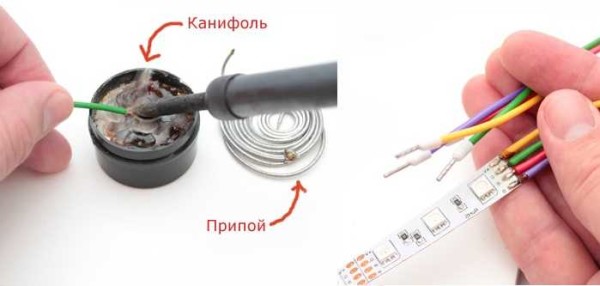
How to connect a diode strip
It is advisable to plummet the contact pads in the same way: dip the soldering iron in rosin, warm up the pad. Make sure that the tin does not leak out of the area.Take the prepared conductor, lay it on the pad, warm it up with a soldering iron. The tin should melt and tighten the conductor. Hold the conductor in place for 10-20 seconds (sometimes it is easier to hold it with thin-nose pliers or tweezers - the conductor heats up), twitch. He must hold on tight. We solder all the necessary conductors in the same way.
On 4-wire RGB strips, be careful not to connect the pads during soldering. The distance between the contacts is very small, the slightest drips can ruin the whole business. Proceed carefully.
Watch the process of soldering a diode tape in the video. You will need to repeat everything.

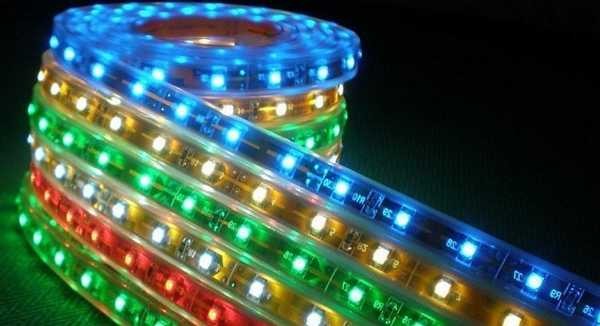
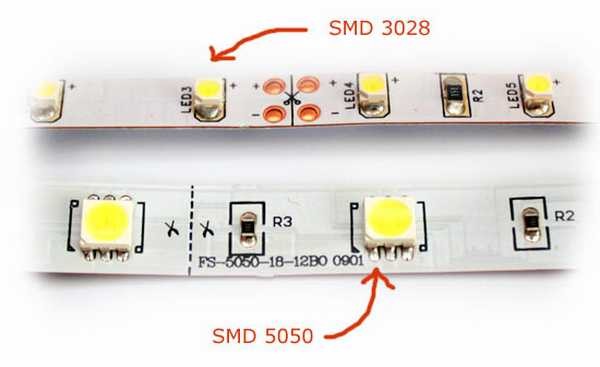

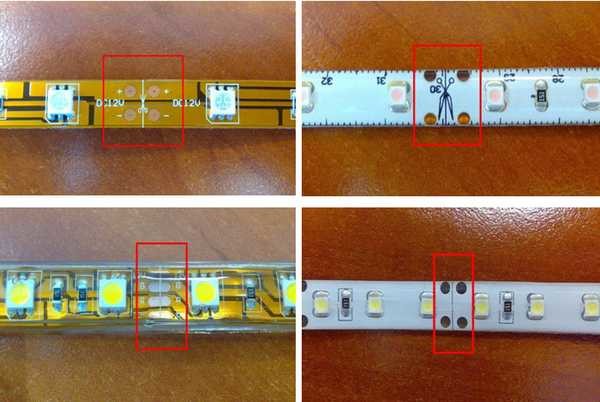
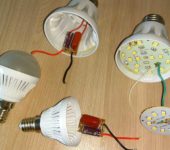
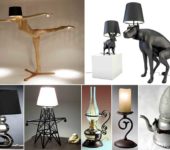
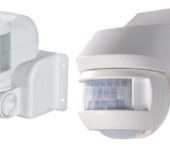
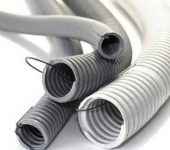
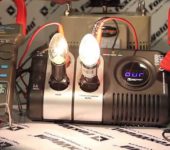





Great article, thanks! Especially useful video. I decided to take a traveling wave, it turns out that a special controller is needed, and a normal power supply fits. A very interesting effect for illuminating the facade of a house.
There is no serial connection here. If you look at how the LEDs are located in the tape, then they are all connected in parallel. Why it is necessary to connect two pieces separately, if one has already 5 meters, - this is so that the tracks do not float due to the passage of current through them.